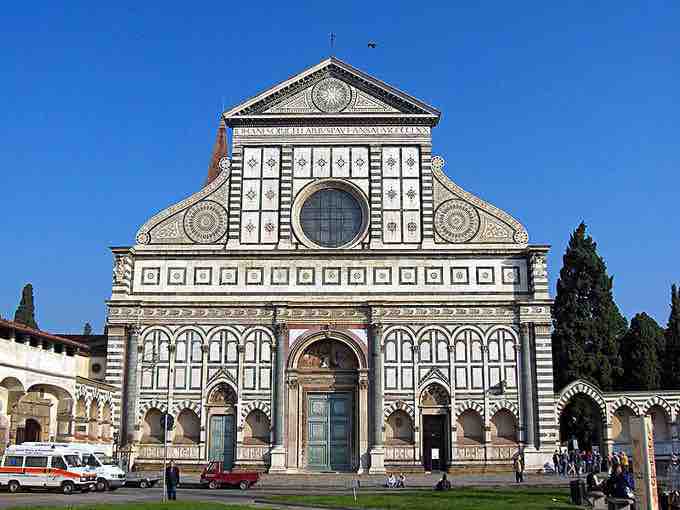The Quattrocento, or the 15th century in Florence, was marked by the development of the Renaissance style of architecture, which represented a conscious revival and development of ancient Greek and Roman architectural elements. The rules of Renaissance architecture were first formulated and put into practice in 15th century Florence, whose buildings subsequently served as an inspiration to architects throughout Italy and Western Europe.
The Renaissance style of architecture emerged in Florence not as a slow evolution from preceding styles, but rather as a conscious development put into motion by architects seeking to revive a golden age. These architects were sponsored by wealthy patrons including the powerful Medici family and the Silk Guild, and approached their craft from an organized and scholarly perspective that coincided with a general revival of classical learning. The Renaissance style deliberately eschewed the complex proportional systems and irregular profiles of Gothic structures. Instead, Renaissance architects placed emphasis on symmetry, proportion, geometry, and regularity of parts as demonstrated in classical Roman architecture. They also made considerable use of classical antique features such as orderly arrangements of columns, pilasters, lintels, semicircular arches, and hemispherical domes.
The person generally credited with originating the Renaissance style of architecture is Filippo Brunelleschi (1377–1446), whose first major commission—the enormous brick dome that covers the central space of the Florence Cathedral—was also perhaps architecturally the most significant. Known as the Duomo, the dome was engineered by Brunelleschi to cover a spanning in the already existing Cathedral. The dome retains the Gothic pointed arch and the Gothic ribs in its design. The dome is structurally influenced by the great domes of Ancient Rome such as the Pantheon, and it is often described as the first building of the Renaissance. The dome is made of red brick and was ingeniously constructed without supports, using a deep understanding of the laws of physics and mathematics. It remains the largest masonry dome in the world and was such an unprecedented success at its time that the dome became an indispensable element in church and even secular architecture thereafter.

Duomo of Florence
The Florence Cathedral is the first example of a true dome in Renaissance architecture.
Another key figure in the development of Renaissance architecture in Florence was Leon Battista Alberti (1402—1472), an important Humanist theoretician and designer, whose book on architecture De re aedificatoria was the first architectural treatise of the Renaissance. Alberti designed two of Florence's best known 15th century buildings: the Palazzo Rucellai and the facade of the church of Santa Maria Novella. The Palazzo Rucellai, a palatial townhouse built 1446–51, typified the newly developing features of Renaissance architecture, including a classical ordering of columns over three levels and the use of pilasters and entablatures in proportional relationship to each other.
Palazzo Rucellai, Florence
Designed by Leon Battista Alberti between 1446–1451.
The facade of Santa Maria Novella (1456–70) also showed similar Renaissance innovations based on classical Roman architecture. Alberti attempted to bring the ideals of humanist architecture and proportion to the already existing structure while creating harmony with the existing medieval facade. His contributions included a classically inspired frieze decorated with squares, four white-green pilasters, and a round window crowned by a pediment with the Dominican solar emblem and flanked on both sides by S-shaped scrolls. While the pediment and the frieze were inspired by classical architecture, the scrolls were new and without precedent in antiquity, and ended up becoming a very popular architectural feature in churches all over Italy.

Santa Maria Novella
Façade of Santa Maria Novella church in Florence, designed by Alberti
The buildings of the early Renaissance in Florence expressed a new sense of light, clarity, and spaciousness that reflected the enlightenment and clarity of mind glorified by the philosophy of Humanism.